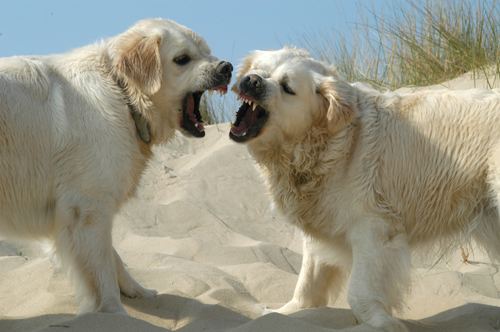Your cart is currently empty!
IS MY DOG AGGRESSIVE?

A growl, a bark, a lunge, a snap, rough play, noisy play. How do we know if our dog is aggressive?
Read the information below and then take the quiz at the bottom the page to see if your dog is at risk.
Normal or Abnormal?
It is important to know that dog aggression is often a normal behaviour [1]. Surprisingly, abnormal canine behaviour is often over-diagnosed.[2] All dogs have the potential to behave aggressively or show aggressive signalling. Aggressive signalling such as growling, snapping, etc. often occurs in contexts where aggressive behaviour may be considered appropriate.
For example, any situation where a dog is threatened is certainly an occasion where a dog might behave aggressively. A situation where a dog is trapped and cannot escape something that is frightening or irritating may also be normal behaviour.
However we would hope that the aggression is controlled and doesn’t actually cause harm. However, even in cases where your dog is not behaving appropriately, we shouldn’t look at aggressive behaviour as being bad or wrong. Dogs always have a reason for acting the way they do.
However, just because your dog is considered normal, doesn’t mean a situation can’t develop. Normal dogs are often put into situations they can’t handle and this can cause a problem to develop.
Dog Play or Dog Aggression

Different dogs and different breeds have different play styles. For example greyhounds may chase and nip, while terriers might wrestle. Some dogs will make growling sounds while they play, or bare their teeth. So if your dog being serious or not?
The biggest difference between dogs that wrestle and those that are fighting is the speed and intensity in which they are moving. Dogs move so fast during a fight that it’s often not possible to tell what is going on. You never have any doubt that it’s a fight or an attack.
However, some play can become very intense, and some play can escalate into aggression. Like with kids, sometimes play simply no longer feels fun, and a child might not recognize when to stop.
Teaching your dog a very reliable recall is the best way to safeguard for this scenario. Them before any play gets very intense, routinely call your dog away from the play to sit calmly for a treat.
When is dog aggression a problem?
When dogs perceive a threat when there clearly isn’t one, or the dog is clearly over-reacting, he or she is not behaving normally. When aggression starts to interfere with the relationship between the pet and the owner, other people, or other animals, it becomes a problem and we need to take steps to improve the situation. Often when this happens, most dogs with behavior problems are not just misbehaving: they are not normal. Typically these dogs have developed an underlying anxiety problem that is contributing to the aggression issue. To treat these dogs as normal, but misbehaving and to expect a normal response to corrections can be dangerous.[3] There are right and wrong ways to handle dog aggression. Read more on the right treatment methods.
Does your dog have an aggression problem? Take the quiz below:
Select the most appropriate answers from the 9 questions.
References
[1]Canine Aggression: Neurobiology, Behavior and Management, Ilana R. Reisner, DVM, Phd, DACVB, Originally appeared on : http://www.vetshow.com/friskies/cani.htm
[2]Dtsch Tierarztl Wochenschr 1991 Jan;98:15-9 [Behavior disorders on Dogs — study of their classification] [Article in German] Feddersen-Petersen D. Institut fur Haustierkunde, Universität Kiel
[3] Clinical Behavioral Medicine for Small Animals, Karen L. Overall, M.A., V.M.D., Ph.D. Diplomate, American College of Veterinary Behavior, Department of Clinical Studies, School of Veterinary Medicine, University of Pennsylvania, Philadelphia. Pennsylvania, Mosby, Inc. 1997
ADVERTISEMENT

Keep people away with our Stand back shirts

Anxious Dog Shirts only available in our shop

